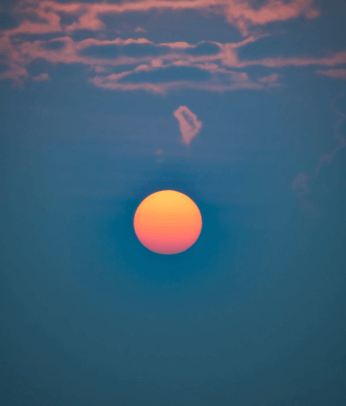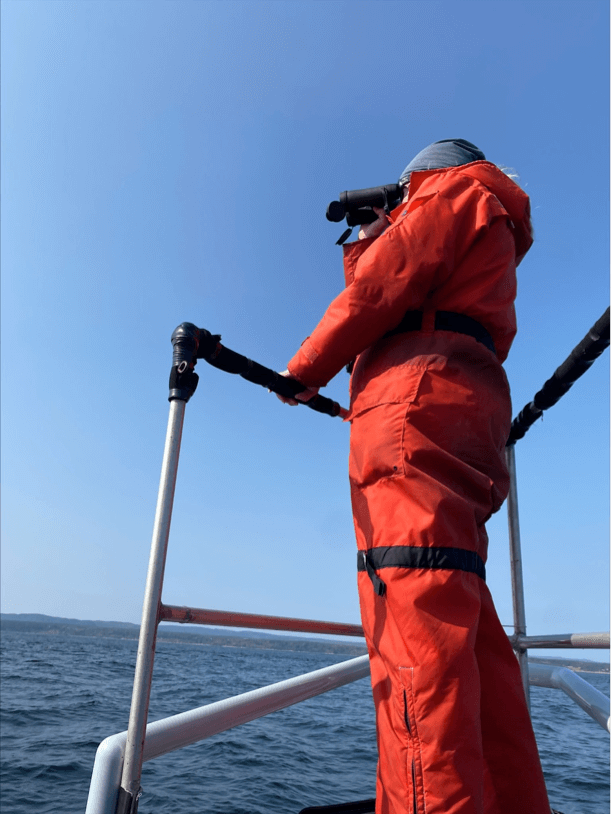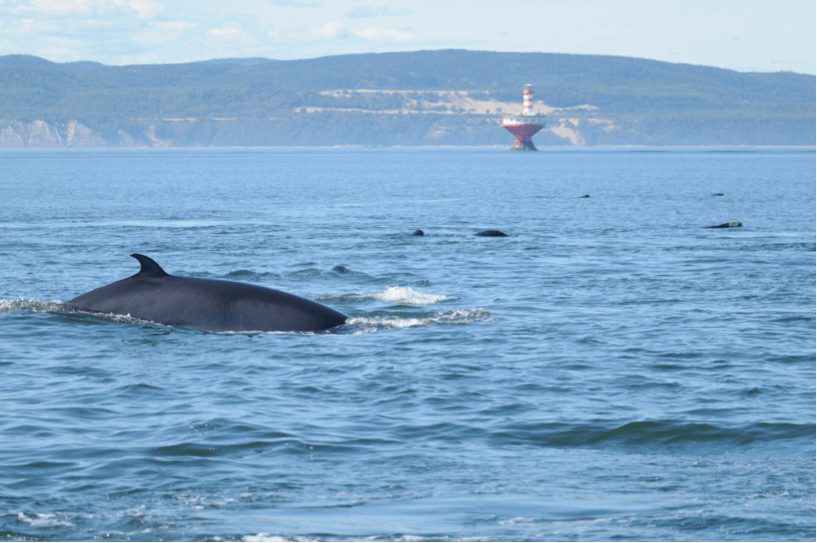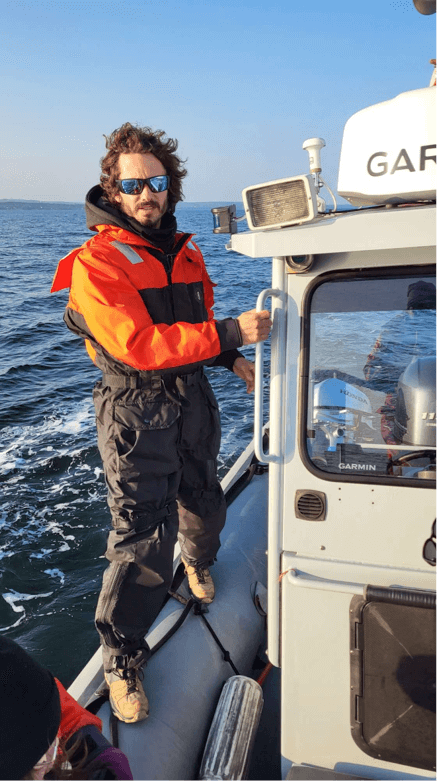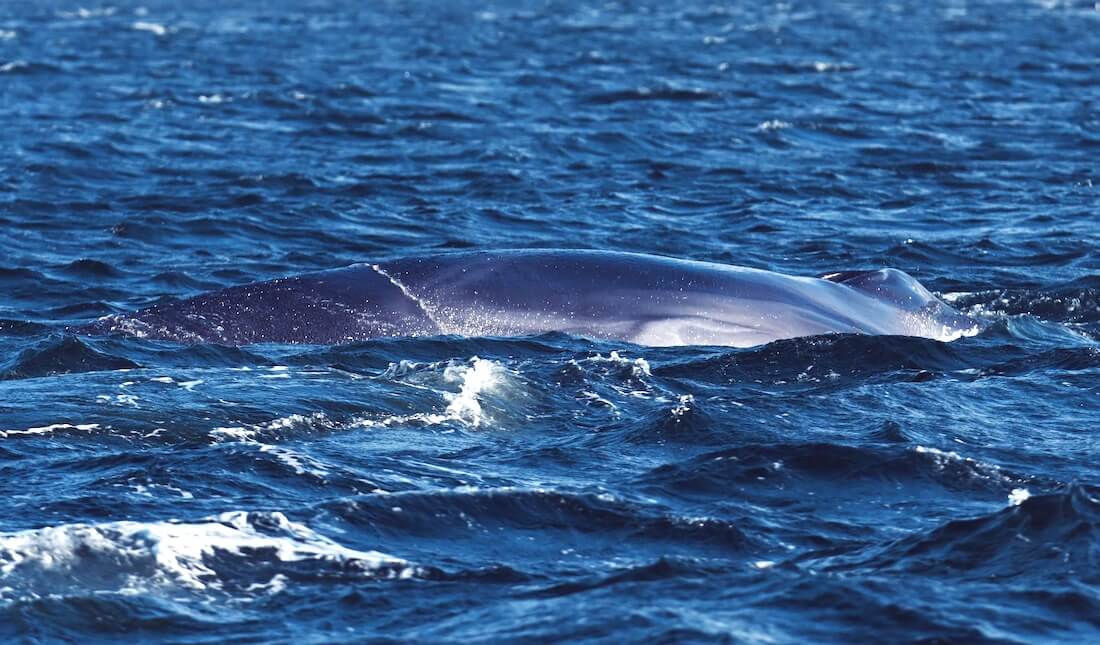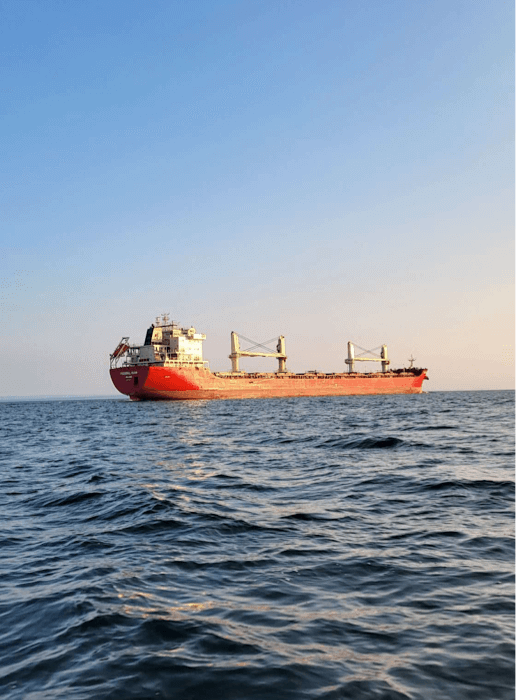It’s 5:45 a.m., and I’m already awake and excitedly waiting for news from the research team of the Group for Research and Education on Marine Mammals (GREMM). This will be my first outing on a research vessel… the first, I hope, of many. As an ecology student and a GREMM’s scientific editor intern, I’m itching to discover the world of marine mammal research.
Could today be the long-awaited opportunity? Will we go out on the water or will the wind and currents put the estuary into one of its frenzies, preventing researchers from venturing out to sea? Or will the fog lift at the last minute, enveloping the landscape in an opaque cloud? This past summer, fog was a frequent occurrence. Shrouding the views of captains and scientists for weeks on end, it led to the cancellation of many days of field work, much to the dismay of my colleagues. Today, however, I’m reassured when I see the weather forecast.
Enjoying my breakfast at the kitchen table, I peer out the window at the darkness as it slowly gives way to the sun. As time passes, I begin to lose hope. I wonder if I should head to the beach instead to admire the rising sun when I finally receive confirmation that I’m expected to show up at work at 7:00. And it’s already 6:45! I wolf down the rest of my meal, put on my backpack full of snacks and extra layers of clothing and make a dash for the door.
Once the equipment is assembled, three members of the research team and I are on our way to the marina where GREMM’s two boats – Le Bleuvet and BpJam – are docked. Our footsteps resonate on the greyish wooden planks aged by the humidity of the salt water. GREMM cooler in hand, I stop for a few seconds to admire the round, bright orange sun floating just above the horizon. With its white boats, the marina takes on warm tones on this beautiful early autumn day. I hop on board the BpJam using the inflatable edges of the small grey Zodiac as a stepping stone. Our captain for the day, Mathieu, turns the key and starts the engine.
At the present time, GREMM is actively carrying out two important research projects: photo-identification of belugas and a similar initiative for large rorquals, namely humpbacks, fin whales and blue whales. The project I’m taking part in today is the second one. On our way to the first observation point, my colleague Stéphanie yells out the answers to my questions while the raging wind muffles our words. She explains to me that most of our field work consists of spotting spouts offshore and then managing to carefully approach the whales to photograph them and, ideally, capture drone images of each animal from the sky. During their outings, the research team sails the estuary on a predetermined course from Tadoussac to the small islands known as Îlets Boisés. At each observation point, they scan the surroundings for at least ten minutes, and if a spout is observed, they set off in the corresponding direction.
The rising sun reflecting off the surface forces me to squint as I scan the horizon for jets of air. Equipped with my fluorescent orange Mustang flotation jacket – essential outerwear for long trips into deep water – I’m protected from head to toe against any inclement weather on the river. Sitting on the edge of the boat, I get sprayed in the back with what’s left of the waves, without even being aware of it.
A few dozen metres in front of the boat, we can make out an obvious delineation in the blue expanse: dark, choppy waters above which gatherings of white seabirds hover, diving here and there between the waves in search of food. These areas are formed by the meeting of cold- and warm-water currents, which generate eddies teeming with small aquatic creatures trapped by the swell. Oftentimes, taking place below the diving gulls and other birds are even more impressive foraging activities: those of baleen whales feeding on the same tiny crustaceans trapped in the tide rips.
Scanning the sea, we are initially baffled by the noisy and particularly conspicuous spouts of minke whales all around us. Large rorquals are generally spotted from afar by their powerful blows spewing into the air. This morning, it’s minke whales that seem to be vying for our attention as they timidly try to imitate the impressive exhalations of their larger cousins. Meanwhile, I try to hold back my excitement at each new sight of a marine mammal – from minke whales to porpoises to grey seals – while each finger pointed at the water in astonishment is a false alarm for my colleagues absorbed in their search for large whales.
After a few minutes, a powerful jet spurts through the churning waters. This one is definitely not a minke. Slowly, Mathieu brings us closer, trying to anticipate where the animal will resurface. Stéphanie quickly gets out her camera and positions herself on her pedestal. Another spout erupts between the waves. And another. Then, like a slow caress, a long greyish back glides across the water surface. This is my first encounter with a fin whale, the second largest mammal in the world.
Unlike humpbacks, fin whales seldom lift their tails. To identify them, specialists look at the patterns of their chevron (milky-white behind the blowhole, more pronounced markings on the right flank), the markings on their curved dorsal fin and the scars on their back.
Unfortunately, this first appearance is inconclusive. The backlit images taken by my colleague offer a spectacular view of the animal, but a poor photo for identification purposes. Laurence, another research assistant on board, was also unable to take out her drone due to the uncooperative weather. So we wait a while before setting off again after the animal. After a few navigation manoeuvres, my colleagues manage to obtain clearer photos in more favourable lighting.
We continue our journey, one observation point after another. Porpoises, minke whales and puffins keep us company while tens of minutes pass without any new sightings. A large group of belugas forging straight ahead dazzle us for a brief moment as they create a stream of glistening white sparks between the waves. Little by little, Channel 8 comes to life as captains on the radio venture out onto the water in search of memorable encounters with whales for their passengers.
As we hear several spouts in the distance, I’m overcome with excitement. Not one, not two, but six humpbacks are waiting for us off the Tadoussac dunes! Sometimes in pairs, sometimes in groups of three, they dive repeatedly, offering us a phenomenal show in the morning light. We launch the drone, but it is hard to keep up with the whales, let alone identify them. Laurence tries as best she can to fly over each of them while the boats jockey for position and the whales pass by. Thanks to effective communication and precise indications from the other crew members, she ultimately succeeds in photographing the majority of individuals from the sky.
After several hours and some arduous tracking, including that of a particularly wary fin whale, we begin our return home. At Îlets Boisés, the waves let loose, lifting the boat into the air before letting it crash with all its weight onto the choppy waters. I try to sit on the inflatable edges of the boat, hoping they will cushion the shocks, but it’s no use. So I sit back down on the only seat on board, enduring the metal bar against my back until the swell subsides.
As we finally leave the turbulent waters, we are greeted by a warm sunset tinting the calm sea pink and gold. As we’re joined by two feeding minke whales, the up-and-down movement of our boat sends ripples across the glassy water while the splashes of their surface activity gleam in the fading light. I return to warmth around 7 that evening, still overwhelmed by the beauties of the day and my legs still wobbly, a lingering reminder of the rocking boat.



